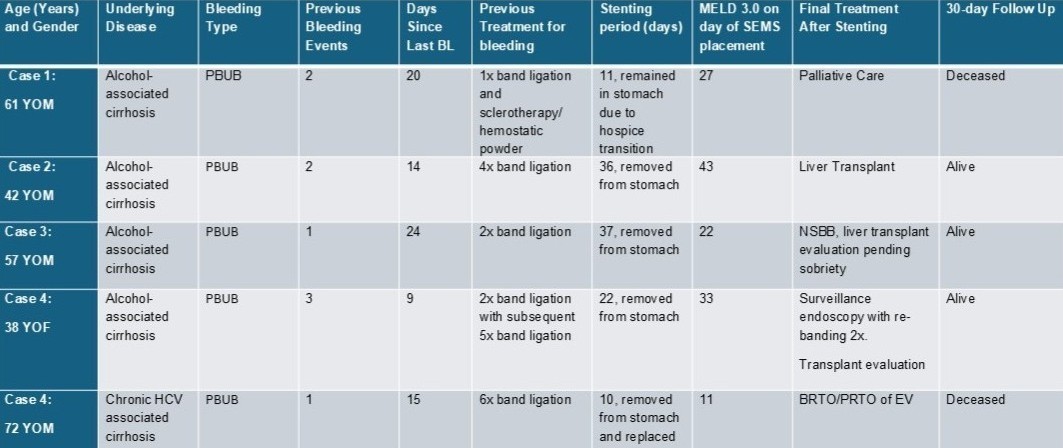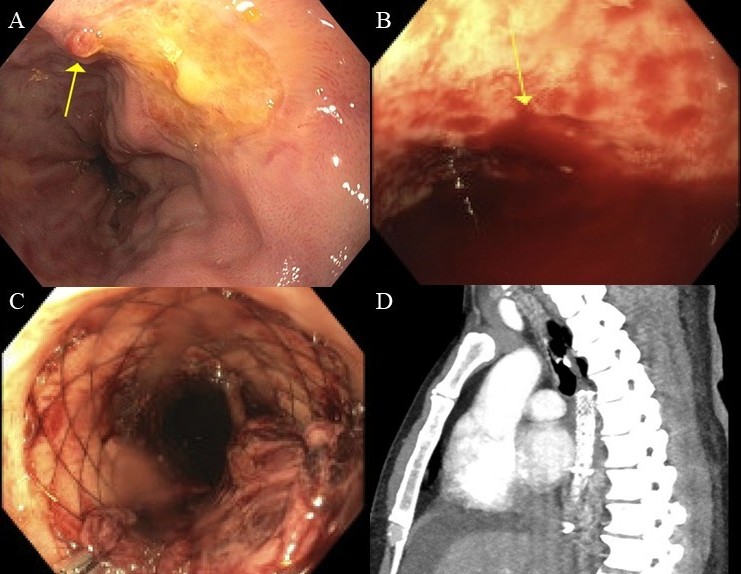Monday Poster Session
Category: Interventional Endoscopy
P3617 - From Banding to Bleeding: Rescue Therapy for Post-Banding Ulcer Bleeding (PBUB) Using Self-Expanding Metal Stents (SEMS)
Monday, October 27, 2025
10:30 AM - 4:00 PM PDT
Location: Exhibit Hall
- HS
Hayden D. Shuster, MD, PharmD (he/him/his)
University of Alabama at Birmingham Hospital
Birmingham, AL
Presenting Author(s)
Hayden D. Shuster, MD, PharmD1, Charles D.. Evers, MD, MBA1, Sujan Ravi, MD, MPH2, Ramzi Mulki, MD2, Ali Ahmed, MD2, Kondal Kyanama, MD2, Shajan Peter, MD3
1University of Alabama at Birmingham Hospital, Birmingham, AL; 2Basil I. Hirschowitz Endoscopic Center of Excellence, The University of Alabama at Birmingham Heersink School of Medicine, Birmingham, AL; 3University of Alabama at Birmingham, Birmingham, AL
Introduction: Esophageal varices are commonly managed with non-selective beta-blockers and endoscopic variceal band ligation (EVBL), based on individual risk profiles and variceal severity. Post-banding ulceration is a recognized complication of EVBL, particularly in patients treated for active variceal bleeding. Management options for post-banding ulcer bleeding (PBUB) include pharmacologic therapy, endoscopic interventions, and transjugular intrahepatic portosystemic shunt (TIPS) placement. However, these modalities are not suitable for all patients, necessitating alternative strategies. This case series explores the use of self-expanding metal stents (SEMS) as an effective but underutilized option for controlling PBUB in such scenarios.
Case Description/
Methods: Five patients with cirrhosis (ages 38–72; mean age 54 years), including four with alcohol-associated cirrhosis and one with hepatitis C-associated cirrhosis, presented with hemodynamically unstable PBUB. All were deemed ineligible for TIPS due to factors such as hepatic encephalopathy, elevated MELD scores, or imminent liver transplantation. A 20x100mm fully covered through the scope SEMS was deployed under endoscopic vision as a bridging measure to control bleeding. Hemostasis was achieved immediately in all cases. Two patients experienced stent migration with recurrent bleeding at 24 hours and ten days post-placement respectively. One of these patients underwent successful repeat SEMS placement followed by liver transplantation. The other continued to bleed despite additional interventions and died. The remaining three patients were discharged alive with two undergoing transplant evaluation and one transferring to hospice care due to poor functional status.
Discussion: This series highlights SEMS as a viable rescue therapy for PBUB in critically ill patients who are not candidates for conventional treatments. SEMS can serve as an effective bridging strategy to definitive interventions such as liver transplantation or TIPS in hemodynamically unstable patients. However, while SEMS provided prompt hemostasis in all cases, stent migration posed a notable risk for rebleeding and warrants vigilant post-placement monitoring.

Figure: Table 1: Case Characteristics
Abbreviations: YOM, year-old male; YOF, year-old female; BL, band ligation; SEMS, self-expandable metal stent; PBUB, post banding ulcer bleeding; mm, millimeters; MELD, model for end-stage liver disease; NSBB, non-selective beta blocker; BRTO/PRTO, balloon-occlusion/plug-assisted obliteration.

Figure: Figure 1: Self Expanding Metal Stents (SEMS) as a Bridge to Liver Transplant
A 42-year-old patient with alcohol-associated cirrhosis was found to have a post banding ulcer identified on esophagogastroduodenoscopy (EGD) (A) with plans for self-expanding metal stent (SEMS) placement the following day. However, post-banding ulcer bleeding (PBUB) occurred later that day requiring urgent SEMS placement. The stent migrated into the stomach and recurrent PBUB occurred the following day. Repeat EGD demonstrated active PBUB (B) that was successfully managed with SEMS, achieving hemostasis (C). Due to concern for concomitant pulmonary embolus at time of EGD, CT angiography chest with and without contrast demonstrated SEMS in place (D) and no pulmonary embolus. The patient had a liver transplant the following day and continues to do well at outpatient follow-up.
Disclosures:
Hayden Shuster indicated no relevant financial relationships.
Charles Evers indicated no relevant financial relationships.
Sujan Ravi indicated no relevant financial relationships.
Ramzi Mulki indicated no relevant financial relationships.
Ali Ahmed indicated no relevant financial relationships.
Kondal Kyanama: Ambu – Consultant. Olympus – Consultant. Pentax – Grant/Research Support.
Shajan Peter: Castle Bioscience – Advisory Committee/Board Member. Olympus – Advisory Committee/Board Member.
Hayden D. Shuster, MD, PharmD1, Charles D.. Evers, MD, MBA1, Sujan Ravi, MD, MPH2, Ramzi Mulki, MD2, Ali Ahmed, MD2, Kondal Kyanama, MD2, Shajan Peter, MD3. P3617 - From Banding to Bleeding: Rescue Therapy for Post-Banding Ulcer Bleeding (PBUB) Using Self-Expanding Metal Stents (SEMS), ACG 2025 Annual Scientific Meeting Abstracts. Phoenix, AZ: American College of Gastroenterology.
1University of Alabama at Birmingham Hospital, Birmingham, AL; 2Basil I. Hirschowitz Endoscopic Center of Excellence, The University of Alabama at Birmingham Heersink School of Medicine, Birmingham, AL; 3University of Alabama at Birmingham, Birmingham, AL
Introduction: Esophageal varices are commonly managed with non-selective beta-blockers and endoscopic variceal band ligation (EVBL), based on individual risk profiles and variceal severity. Post-banding ulceration is a recognized complication of EVBL, particularly in patients treated for active variceal bleeding. Management options for post-banding ulcer bleeding (PBUB) include pharmacologic therapy, endoscopic interventions, and transjugular intrahepatic portosystemic shunt (TIPS) placement. However, these modalities are not suitable for all patients, necessitating alternative strategies. This case series explores the use of self-expanding metal stents (SEMS) as an effective but underutilized option for controlling PBUB in such scenarios.
Case Description/
Methods: Five patients with cirrhosis (ages 38–72; mean age 54 years), including four with alcohol-associated cirrhosis and one with hepatitis C-associated cirrhosis, presented with hemodynamically unstable PBUB. All were deemed ineligible for TIPS due to factors such as hepatic encephalopathy, elevated MELD scores, or imminent liver transplantation. A 20x100mm fully covered through the scope SEMS was deployed under endoscopic vision as a bridging measure to control bleeding. Hemostasis was achieved immediately in all cases. Two patients experienced stent migration with recurrent bleeding at 24 hours and ten days post-placement respectively. One of these patients underwent successful repeat SEMS placement followed by liver transplantation. The other continued to bleed despite additional interventions and died. The remaining three patients were discharged alive with two undergoing transplant evaluation and one transferring to hospice care due to poor functional status.
Discussion: This series highlights SEMS as a viable rescue therapy for PBUB in critically ill patients who are not candidates for conventional treatments. SEMS can serve as an effective bridging strategy to definitive interventions such as liver transplantation or TIPS in hemodynamically unstable patients. However, while SEMS provided prompt hemostasis in all cases, stent migration posed a notable risk for rebleeding and warrants vigilant post-placement monitoring.

Figure: Table 1: Case Characteristics
Abbreviations: YOM, year-old male; YOF, year-old female; BL, band ligation; SEMS, self-expandable metal stent; PBUB, post banding ulcer bleeding; mm, millimeters; MELD, model for end-stage liver disease; NSBB, non-selective beta blocker; BRTO/PRTO, balloon-occlusion/plug-assisted obliteration.

Figure: Figure 1: Self Expanding Metal Stents (SEMS) as a Bridge to Liver Transplant
A 42-year-old patient with alcohol-associated cirrhosis was found to have a post banding ulcer identified on esophagogastroduodenoscopy (EGD) (A) with plans for self-expanding metal stent (SEMS) placement the following day. However, post-banding ulcer bleeding (PBUB) occurred later that day requiring urgent SEMS placement. The stent migrated into the stomach and recurrent PBUB occurred the following day. Repeat EGD demonstrated active PBUB (B) that was successfully managed with SEMS, achieving hemostasis (C). Due to concern for concomitant pulmonary embolus at time of EGD, CT angiography chest with and without contrast demonstrated SEMS in place (D) and no pulmonary embolus. The patient had a liver transplant the following day and continues to do well at outpatient follow-up.
Disclosures:
Hayden Shuster indicated no relevant financial relationships.
Charles Evers indicated no relevant financial relationships.
Sujan Ravi indicated no relevant financial relationships.
Ramzi Mulki indicated no relevant financial relationships.
Ali Ahmed indicated no relevant financial relationships.
Kondal Kyanama: Ambu – Consultant. Olympus – Consultant. Pentax – Grant/Research Support.
Shajan Peter: Castle Bioscience – Advisory Committee/Board Member. Olympus – Advisory Committee/Board Member.
Hayden D. Shuster, MD, PharmD1, Charles D.. Evers, MD, MBA1, Sujan Ravi, MD, MPH2, Ramzi Mulki, MD2, Ali Ahmed, MD2, Kondal Kyanama, MD2, Shajan Peter, MD3. P3617 - From Banding to Bleeding: Rescue Therapy for Post-Banding Ulcer Bleeding (PBUB) Using Self-Expanding Metal Stents (SEMS), ACG 2025 Annual Scientific Meeting Abstracts. Phoenix, AZ: American College of Gastroenterology.
